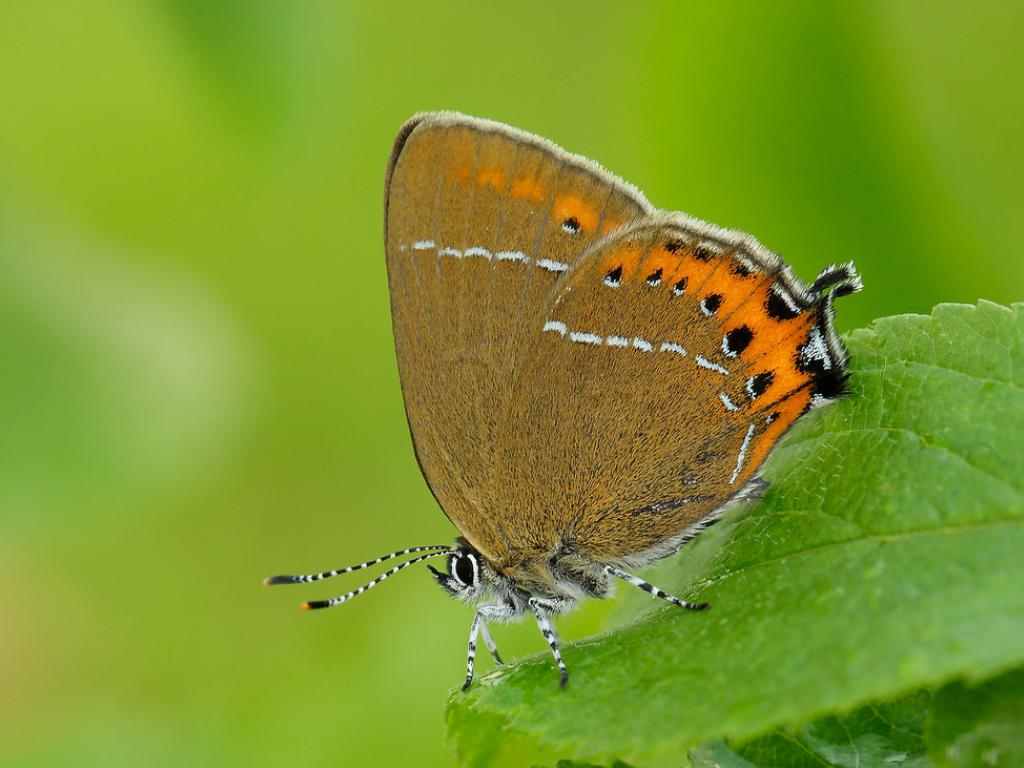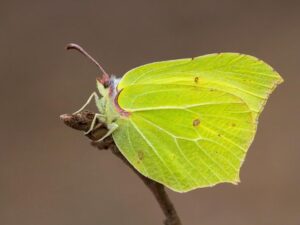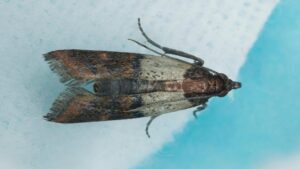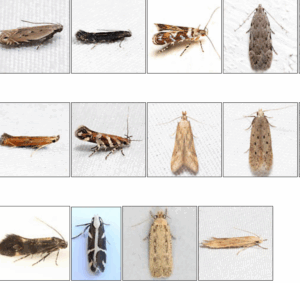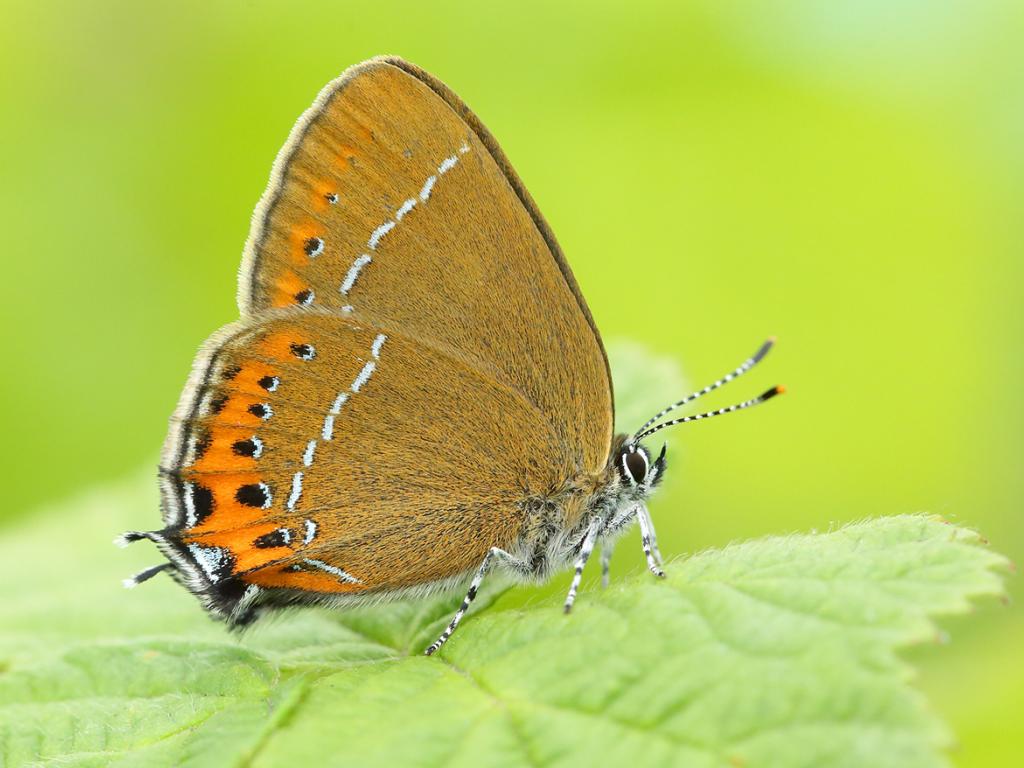
The Black Hairstreak is one of our most elusive butterflies. It is found only in thickets of Blackthorn in woodlands on heavy clay soils between Oxford and Peterborough in the East Midlands of England.
Underwings are brown with red edges, a row of black spots, a white streak, and small tails. Upperwings are brown with red edges. White-letter Hairstreak is similar but lacks row of black spots and has more obvious W-shaped streak.
The adults spend nearly all their time in the canopies of trees of dense scrub where they feed on honeydew secreted by aphids. At certain times they make short looping flights in and out of the tree tops with a peak of activity around midday.
The adults are easy to confuse with those of the White-letter Hairstreak and Purple Hairstreak which fly at the same time of year, care is needed to confirm the identification of the underside marking, which has a row of black spots in the outer orange marking and may have a white ‘W’.
The Black Hairstreak declined steadily during the twentieth century and is now reduced to around 50 sites. Adult butterflies do not fly far and an entire colony will often confine itself to a single area within a wood, despite there being suitable habitat nearby. This inability to colonise new areas at a pace in balance with habitat loss, including hedge cutting, may partially explain the scarcity of this species.
Size and Family
- Family: Hairstreaks
- Size: Small/Medium
- Wing Span Range (male to female): 37mm
Conservation Status
- Butterfly Conservation priority: High
- Protected under Schedule 5 of the Wildlife and Countryside Act (for sale only)
- A regional priority in East Midlands, East of England and South East England.
Caterpillar Foodplants
Blackthorn (Prunus spinosa) is almost exclusively used, but occasionally Wild Plum (P. domestica) and other Prunus species are used.
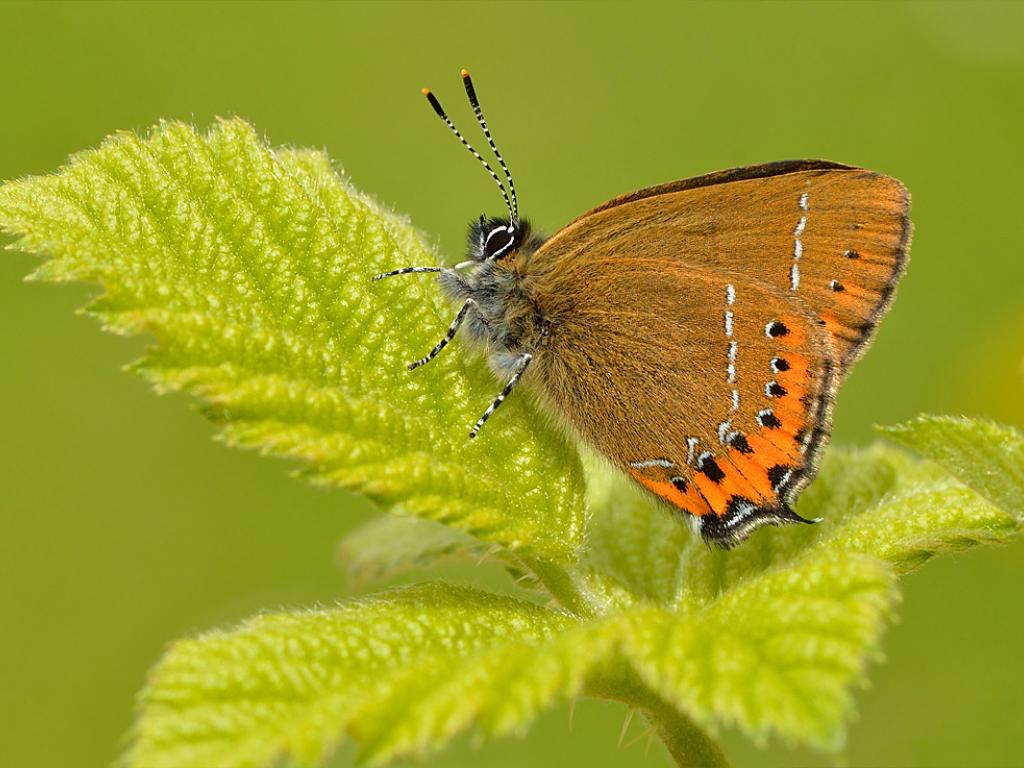
Lifecycle

Life cycle
The butterfly is single-brooded with adults flying in a short period from early June to mid-July.The adults often congregate on Field Maple (Acer campestre) or Ash (Fraxinus excelsior),possibly because these trees contain large aphid populations that produce abundanthoneydew. They are rarely seen at ground level but sometimes come down to feed onflowers of Wild Privet (Ligustrum vulgare), Dog-rose (Rosa canina) or bramble (Rubus spp.).Eggs are laid singly, usually on the bark of young growth (2-3 years old) on mature Blackthorn(over 10 years old). Most eggs are laid above 1.5m from the ground though small numbersare laid lower down on Blackthorn suckers. The eggs last through the winter and hatch inthe spring, just before bud-burst, when the young larvae feed on the developing flower buds.Older larvae feed on the leaves, which they resemble closely. They move to pupate on thetop of Blackthorn leaves or twigs, often in exposed positions, where the conspicuous blackand white pupae resemble bird droppings.
Habitat
Most colonies breed in dense mature stands of Blackthorn growing in sunny, sheltered areas – usually along wood edges, edges of rides and glades or hedgerow thickets. Some smaller colonies occur in shady situations such as canopy gaps in mature woodland, small scrub patches or sheltered hedgerows.
Most colonies breed in dense mature standsof Blackthorn growing in sunny, shelteredsituations, usually along wood edges, the edgesof rides or glades, or along hedgerow thickets.Smaller colonies occur in more exposed orshady situations, such as canopy gaps inmature woodland, small patches of scrubor in sheltered hedgerows.
The Black Hairstreak is one of our most elusive butterflies, foundonly in thickets of Blackthorn in woodlands on heavy clay soilsbetween Oxford and Peterborough in the East Midlands of England.The adults spend nearly all their time in the canopies of trees ordense scrub where they feed on honeydew secreted by aphids.At certain times they make short looping flights in and out of thetree tops. Butterflies can be seen from early morning to earlyevening with a peak of activity around midday. The adults areeasy to confuse with those of the White-letter Hairstreak andPurple Hairstreak which fly at the same time of year, so care isneeded to confirm identification of the underside marking, whichhas a row of black spots in the outer orange margin and mayhave a white ‘W’. The Black Hairstreak declined steadily duringthe twentieth century, with the majority of the remaining 50 orso sites in Oxfordshire and Buckinghamshire, where severalrecently discovered colonies suggests something of a recovery.
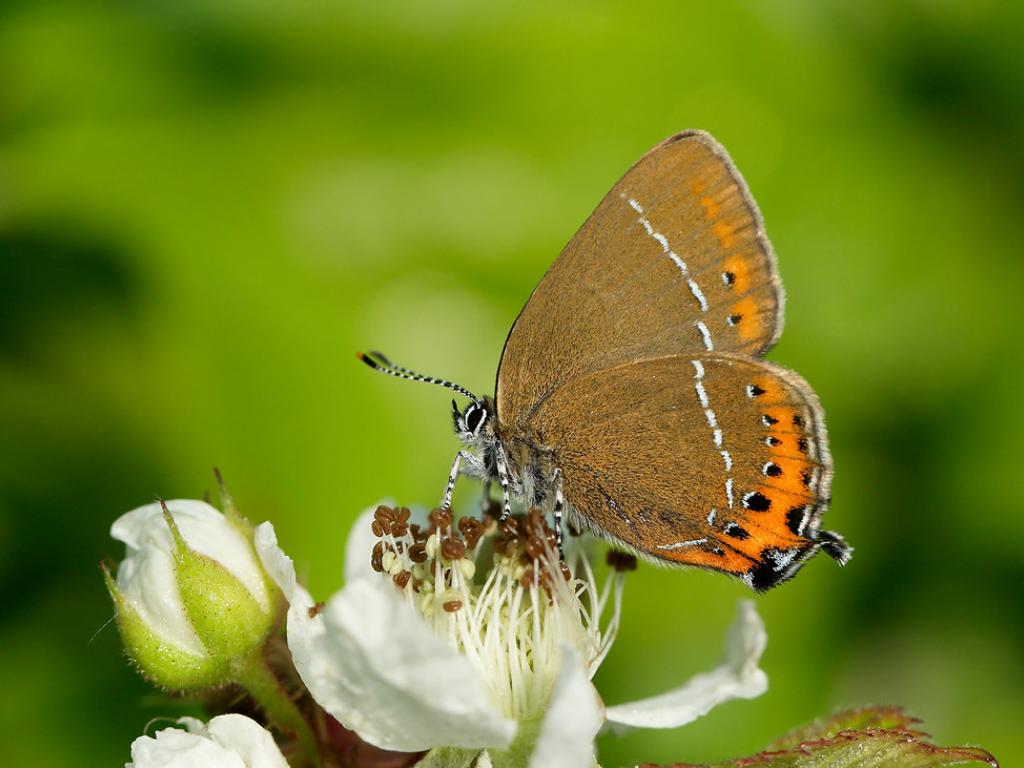
The black hairstreak is a rare butterfly that is restricted to woodlands and hedgerows containing blackthorn – the foodplant of the caterpillar. It is both elusive and hard to tell apart from other hairstreaks.
The black hairstreak is the UK’s rarest hairstreak, but is more widespread in Europe. In the UK, it is only found in mature woodland and hedgerows in the East Midlands, Oxfordshire and Buckinghamshire. This species does not travel or disperse over great distances.
Adults are on the wing for a short period over June and July, but are very elusive, spending much of their time in dense blackthorn scrub or in the canopy where they feed on honeydew secreted by aphids. Blackthorn is the main foodplant of the caterpillars.
How to identify
The upperwing of the Black hairstreak is brown with orange spots. The underwing is brown with an orange streak. There is a row of black spots near the margin and a thin white streak across the underwing. It is very similar to the white-letter hairstreak and these species are extremely difficult to tell apart while in flight.
Did you know?
Caterpillars go through a serious of moults, called ‘instars’, before they mature, often looking quite different each time. The older caterpillars of the black hairstreak bear a striking resemblance to the blackthorn leaves on which they feed – a great form of camouflage.
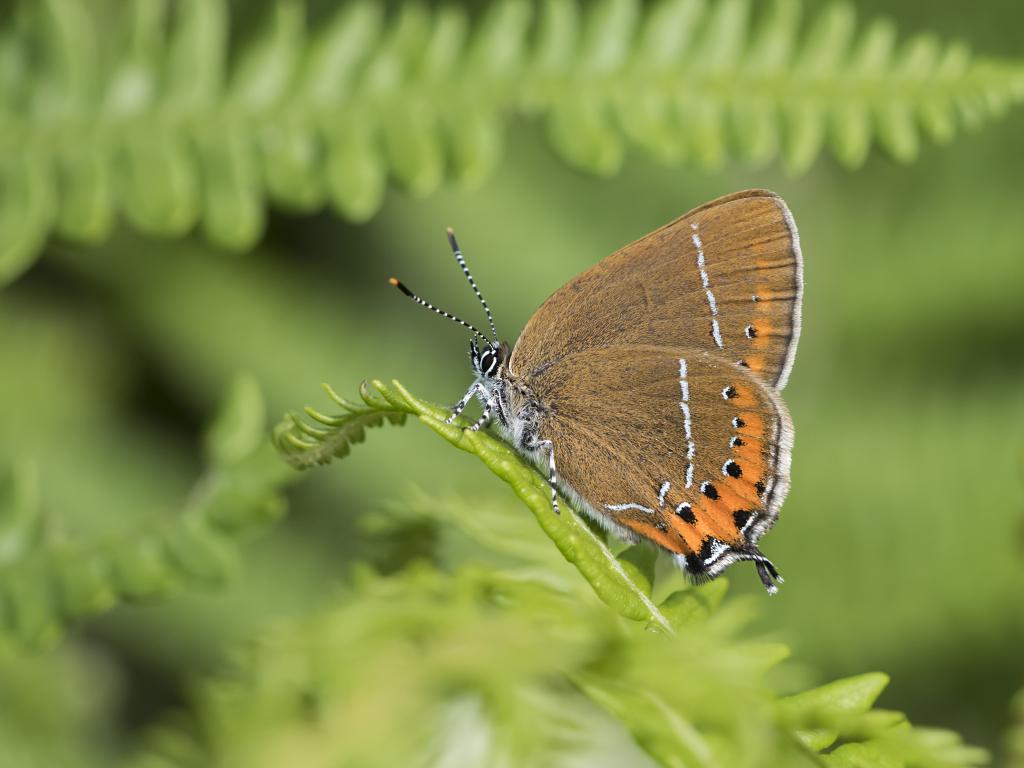
How people can help
The Wildlife Trusts manage many woodland nature reserves sympathetically for the benefit of all kinds of butterflies, including the speckled wood. A mix of coppicing, scrub-cutting, ride maintenance and non-intervention all help woodland wildlife to thrive. You can help too: volunteer for your local Wildlife Trust and you could be involved in everything from traditional forest crafts to surveying for butterflies.
The Black Hairstreak is one of our rarest butterflies and one of the most recently discovered, due to the similarity with its close cousin, the White-letter Hairstreak. This species was first discovered in the British Isles in 1828 when a Mr. Seaman, an entomological dealer, collected specimens from one of the most famous sites for this species – Monk’s Wood in Cambridgeshire. These were thought to be specimens of the White-letter Hairstreak until Edward Newman, a Victorian entomologist of note, declared them to be Black Hairstreak.
This butterfly is not a great wanderer and an entire colony will often confine itself to a single area within a wood, despite there being suitable habitat nearby. The inability to colonise new areas at a pace in balance with habitat loss may partially explain the scarcity of this species. This butterfly has a very restricted distribution that follows a line of clays between Oxfordshire in the south-west and Cambridgeshire in the north-east.
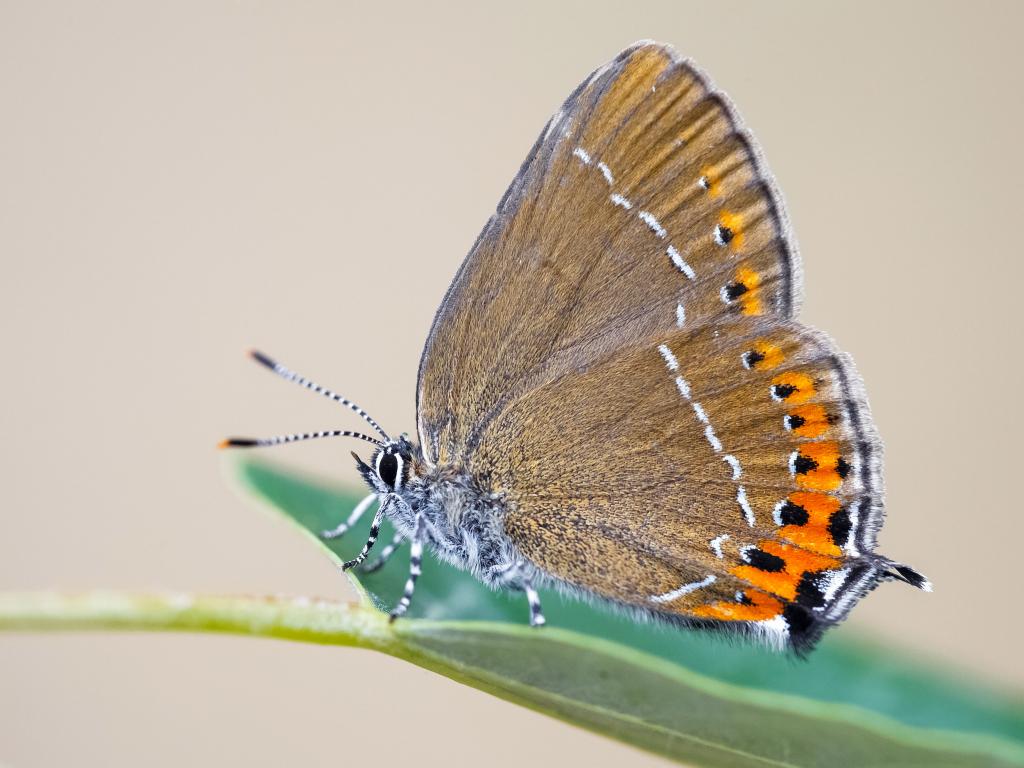
Black Hairstreak (Satyrium pruni)
Description
Wing span: 34-40 mm. The Black Hairstreak is one the rarest British butterflies and one of the most recently discovered, due to its similarity to the White-letter Hairstreak. The main distinguishing feature between the two is that the Black Hairstreak has a row of distinctive black dots running along the inside of the orange band on the underside of the hindwing; these are absent in the White-letter Hairstreak. Males and females are similar, but the hindwing tails are longer in females. They always rest with their wings closed. This species has a very restricted distribution that follows a line of clay soils between Peterborough and Oxford. Black Hairstreak colonies are typically located in small woods or nearby hedgerows, where stands of mature Blackthorn grow. Sites are located in sheltered but sunny positions and have a southerly aspect to them.
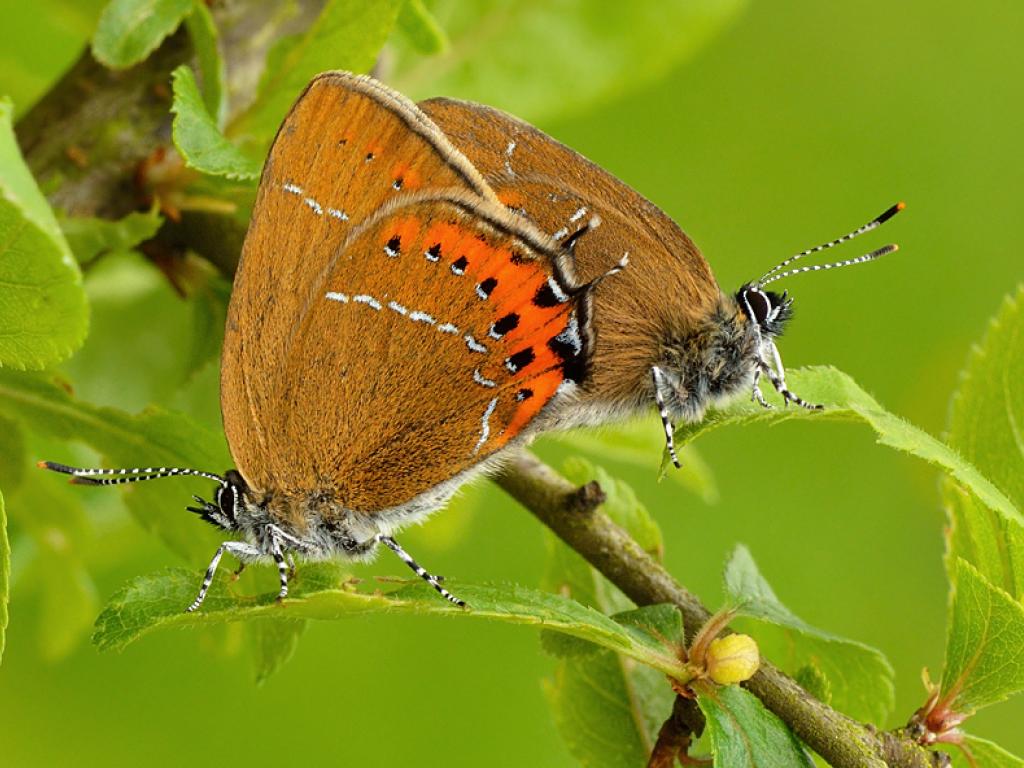
Life Cycle
The Black Hairstreak has a short flight period, with the adults normally being seen from early June to the first week of July. The ovum is the over-wintering stage.
Larval Foodplants
The primary larval food plant is Blackthorn (Prunus spinosa).
Nectar Sources
As well as aphid honeydew, adults will also take nectar from flowers such as Wild Privet, Dog Rose and Bramble.
Have you seen the elusive Black Hairstreak?
Did you know, one of the UK’s most elusive butterflies lives in the historic Wychwood area? At rest and from a distance little more than smallish triangles, a closer look at the black hairstreak reveals their gorgeous red scalloped edges, black spots, white linear patterning and delicate tail. Though similar to the white-letter hairstreak, the two butterflies can be distinguished with care. White-letter hairstreaks lack the row of black spots on the hind underwing, and the white stripe on their wings forms a distinctive ‘W’ shape.
Possibly a naturalised introduction, black hairstreaks can only be found in thickets of blackthorn on the heavy clay soils between Oxfordshire and Peterborough. Their caterpillars feed almost exclusively on blackthorn, and initially after metamorphosis the butterflies don’t stray far from this shrub. As they age, black hairstreaks move up into the tree canopy where they feed on aphid honeydew. They are seldom seen at ground level, but occasionally descend to feed on the nectar of wild privet and other flowers. Black hairstreaks always settle with their wings closed, a helpful tip for identification.
In recent years, black hairstreaks’ status as ‘woodland butterflies’ has been challenged. Blackthorn is early successional stage scrub, and as woodland matures around it the plant is shaded out. Today black hairstreak colonies are more often found in hedgerows than mature woodland.
Black hairstreaks are usually on the wing in mid-June, but this year are experiencing a late flight period. Keep an eye out for them next you are near a mixed-age blackthorn hedgerow!

